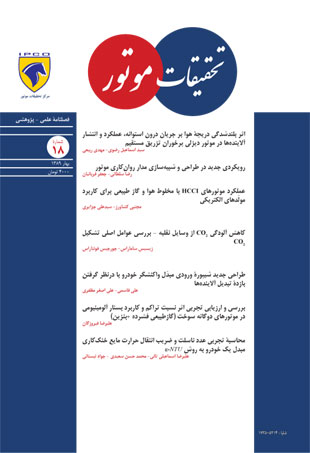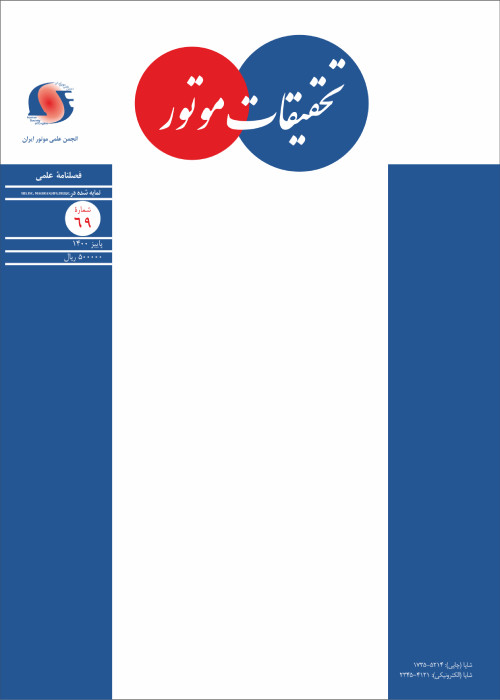فهرست مطالب

نشریه تحقیقات موتور
پیاپی 18 (بهار 1389)
- بهای روی جلد: 40,000ريال
- تاریخ انتشار: 1389/03/03
- تعداد عناوین: 7
-
-
Page 3A computational optimization was performed for a direct-injection diesel engine using three-dimensional modeling. Fully transient CFD analyses of different valve profile strategies for the intake and compression strokes are performed, to evaluate the effects on both engine performance and in-cylinder flow-field evolution. The turbulence model was used along with second order linear upwind scheme. Modifications are applied to intake valve for five different valve lift profiles. Organized flow structures (i.e., swirl) and turbulent flow patterns are investigated, in order to address the rules for ad-hoc strategies aiming at finding the best trade-off between the engine performance and pollutant emission. At first, results for the base case are validated against experiments at maximum power operation (2000 rpm); subsequently, four valve lift profiles, are performed. Relative valve profiles prove to influence the flow field within the combustion chamber, and therefore the subsequent spray evolution and fuel combustion, confirming the importance of an ad-hoc optimization.
-
Page 12For developing more efficient engines, it is essential to optimize the lubrication circuit of the power train systems. In this paper during an engine design and development process, a network analysis of the engine lubrication system is described in detail. Two elements were added to lubrication circuit in the modified engine. These elements are hydraulic lifters and an Anti-drain valve. The effect of adding and changing mentioned elements and increasing bearing clearance has been investigated on oil pump capacity. Also, chain tensioner and anti-drain valve as two new important components in the lubrication system have been investigated as well as other components from tribological point of view. Improving chain tensioner material from Nitride Butyl Rubber to Poly-Amid and changing the oil jet hole position and diameter, reduce intensity of wear to the standard level without significant decreasing of main galley pressure. Adding an anti-drain valve near to hydraulic lifter gallery decreases the time which oil needs to reach lifters with sufficient pressure at engine startup. The analyses are done by Flowmaster7.6 and AVL-EXCITE7.02 software and an accessory code. Finally, theoretical results are validated by completely controlled lubrication functional test.
-
Page 20Homogenous Charge Compression Ignition (HCCI) is a mode of combustion in IC engines in which premixed fuel and air is ignited spontaneously. There is a belief that HCCI engines have a great potential to improve fuel consumption and reduce NOx emissions.In this study, a single zone, zero dimensional, thermo-kinetic model has been developed and a computer program with MATLAB software is used to predict engine performance characteristics. This model has been used to predict the principal parameters of controlling auto-ignition to acceptable level and this work leads to achieving the working region with two limitations for knock and misfire. The cycle is simulated with premixed blend of methane and DME with air.Also NOx emission are compared in a diesel engine working as a conventional diesel and at HCCI mode.
-
Page 32The demand for fossil fuel in the transport sector is constantly increasing and transportation is ranked amongst the highest greenhouse emitting sectors globally. Tackling CO2 emissions from road transport is today a widely discussed topic and constitutes a milestone towards reaching a sustainable, carbon neutral, economy. This challenge is being described in various initiatives adopted in the European Union and other parts of the world. Several measures have been proposed and adopted so far for reversing the increasing greenhouse gas emissions trends. This paper attempts an overview of the existing policy framework in various countries focusing on European Union. In addition, the main technical measures proposed and promoted in this direction are presented and evaluated with respect to their greenhouse reduction potential. Special attention is given to emerging technologies such as hybrid vehicles and biofuels. The main factors differentiating the officially reported CO2 emissions from actual real life emissions are discussed and a brief evaluation of current European policy is presented.
-
Page 42The monolithic catalytic converter still is the main pollution control device for modern vehicles in order to reach the ever-increasing legislative demands for low emission standards. The catalytic converters require a large expansion from the exhaust pipe to the front face of the monolith. Unfortunately, packaging constraints often do not permit the use of long diffusers. Hence, flow separation within the diffuser leads to a non-uniform flow distribution across the monolith. A uniform flow distribution at the inlet monolith face is favorable for the conversion efficiency as well as the durability of the catalytic converter. Therefore the main problem is to optimize the flow distribution at the catalytic converter. It should be noted that due to flow maldistribution in an enlarged inlet of catalytic converter, some part of the monolith would be non effective. In this research a new design for inlet diffuser of catalytic converter has been proposed and fabricated. The new inlet diffuser is composed of some tube to tube cones that distribute the flow uniformly at the entrance face of monolith. Temperature, pressure drop and concentration of pollutants, before and after catalyst, have been measured. The results show that the new design for inlet diffuser tends in less uniform temperature field at the entrance of monolith but the flow distribution becomes more uniform and an increased conversion efficiency of catalyst will be obtained.
-
Page 51The first step in dealing with behavior of an engine on NG mode is the installation of a suitable gas fueling system on the engine. Two generations of gas fueling systems which were studied and installed on research engine are: Mixer type and Sequential system type. The results included performance, emissions and fuel consumption, were recorded and analyzed. The results showed that the sequential gas fueling system is better than mixer type. The power loss in mixer type is higher than the other one. On the other hand fuel consumption and the level of emissions in multi-point sequential gas system are very low.
-
Page 62In this Study, radiator performance for passenger car has been studied experimentally in wide range of operating conditions. Experimental prediction of Nusselt number and heat transfer coefficient for coolant in radiator tubes are also performed with method. The total effectiveness coefficient of radiator and heat transfer coefficient in air side is calculated via try and error method considering experimental data. The Colburn factor and pressure drop are also estimated for this heat exchanger. Examples of application demonstrate the practical usefulness of this method to provide empirical data which can be used during the design stage.


